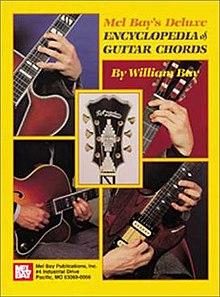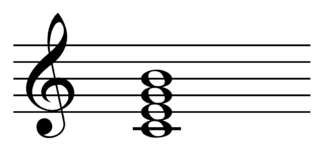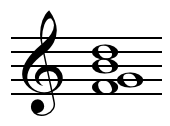This article relies too much on references to primary sources .(January 2016) (Learn how and when to remove this template message) |
 | |
| Author | Mel Bay, William Bay |
|---|---|
| Country | United States |
| Language | English |
| Genre | Music education |
| Publisher | Mel Bay Publications |
Publication date | 1971 |
| Media type | |
| Pages | 144 |
Mel Bay's Deluxe Encyclopedia of Guitar Chords, also known as the Encyclopedia of Guitar Chords or Deluxe Guitar Chord Encyclopedia is a best-selling[ citation needed ] encyclopedia of guitar chords, first published by Mel Bay in 1971. It is a staple in the study and teaching of guitar.

In music, a guitar chord is a set of notes played on a guitar. A chord's notes are often played simultaneously, but they can be played sequentially in an arpeggio. The implementation of guitar chords depends on the guitar tuning. Most guitars used in popular music have six strings with the "standard" tuning of the Spanish classical guitar, namely E-A-D-G-B-E' ; in standard tuning, the intervals present among adjacent strings are perfect fourths except for the major third (G,B). Standard tuning requires four chord-shapes for the major triads.
Mel Bay was a musician and publisher best known for his series of music education books. His Encyclopedia of Guitar Chords remains a bestseller.
The encyclopedia contains 324 different chord types; 27 in each of the 12 keys with thousands of shapes and inversions. The 27 chord types covered in each key are major, minor, diminished, augmented, seventh, minor seventh, seventh augmented fifth, seventh flat fifth, major seventh, major seventh flat third, major seventh flat fifth, seventh suspended fourth, sixth, minor sixth, ninth, minor ninth, major ninth, ninth sharp fifth, ninth flat fifth, seventh flat ninth, seventh sharp ninth, sixth add ninth, eleventh, augmented eleventh, thirteenth, thirteenth flat ninth, and thirteenth flat ninth flat fifth. [1] The chords are "presented in each key and are broken down into melody, inside, rhythm, and bottom four-strings." [2]
The book has since been published in a case-size edition by William Bay, Mel's son and has spawned a series of similar books like the Encyclopedia of Guitar Chord Progressions (first published in 1977 [3] ), Encyclopedia of Guitar Chord Inversions, Mel Bay's Deluxe Guitar Scale Book, Encyclopedia of Jazz Guitar Runs, Fills, Licks & Lines, and Piano, Mandolin and Banjo [4] chord encyclopedias.
The song "Ode to Mel Bay" (written and first recorded by Michael "Supe" Granda of the Ozark Mountain Daredevils and featured on the album The Day Finger Pickers Took Over the World by Tommy Emmanuel and Chet Atkins), is a light-hearted song about Mel Bay's encyclopedia of guitar chords and the books in general. Mentioned in the lyrics, written by Shel Silverstein, is: "On page 21 you showed us how to play a G and on page 22 you showed us how to play a D, but lordy o lordy we never learned to play an E, because someone in the outhouse stole page 23!" [5]

The Day Finger Pickers Took Over the World is an album by American guitarist Chet Atkins and Australian guitarist Tommy Emmanuel. Recorded when Atkins was 73, this was his last release of original material in the 20th century. "Smokey Mountain Lullaby" was nominated for the 1997 Grammy Award for Country Instrumental Performance.

William Thomas Emmanuel is an Australian guitarist, songwriter, and singer, best known for his complex fingerstyle technique, energetic performances, and the use of percussive effects on the guitar. Although originally a session player in many bands, Emmanuel has carved out his own style as a solo artist, releasing award-winning albums and singles. In the May 2008 and 2010 issues of Guitar Player Magazine, he was named "Best Acoustic Guitarist" in its readers' poll. In June 2010 Emmanuel was appointed a Member of the Order of Australia (AM). In 2011, Emmanuel was inducted into the Australian Roll of Renown.

Chester Burton Atkins, known as "Mr. Guitar" and "The Country Gentleman", was an American musician, occasional vocalist, songwriter, and record producer, who along with Owen Bradley and Bob Ferguson, among others, created the country music style that came to be known as the Nashville sound, which expanded country music's appeal to adult pop music fans. He was primarily known as a guitarist. He also played the mandolin, fiddle, banjo, and ukulele.







